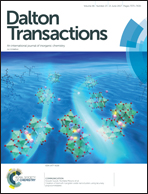Metal–organic frameworks constructed from tib and carboxylate acid ligands: selective sensing of nitro explosives and magnetic properties†
Abstract
Four metal–organic frameworks, namely [Cd2(tib)(btb)(H2O)2]·NO3·2.5DMF (1), [Cd(tib)(H2dhbqdc)0.5(NO3)]·6H2O (2), [Co(tib)(1,4-ndc)]·2DMF (3), and [Cu3(tib)2(2,6-ndc)2(H2O)2]·2NO3·2H2O (4), were synthesized based on 1,3,5-tris(1-imidazolyl)benzene and diverse carboxylic acid ligands. They have been characterized by elemental analysis, infrared spectroscopy (IR), powder X-ray diffraction (PXRD), thermogravimetric analyses (TGA) and single crystal X-ray diffraction. Compound 1 is a 3D framework constructed from a binuclear Cd cluster with (3,3,6)-connected (63)2(69·86) topology. Compound 2 exhibits a 2D wavy layered structure with (3,4)-connected topology, and compound 3 displays a two-fold interpenetrating network with (3,5)-connected topology. Compound 4 can be regarded as a three-fold interpenetrating framework. Moreover, compounds 1 and 2 can be used as fluorescent sensors sensing small molecules with high selectivity. In this context, we selected the typical toxic explosives, TNP, namely 2,4,6-trinitrophenol and NB, namely nitrobenzene, as examples to investigate the properties of sensing. Furthermore, the magnetic properties of compounds 3 and 4 are investigated.



 Please wait while we load your content...
Please wait while we load your content...